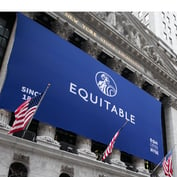Editor’s note: Life Insurance Selling magazine is merging with National Underwriter Life & Health as of January 2014. In honor of LIS’ illustrious 87-year history, here is an interesting look back at the magazine’s first 25 years, as excerpted from the Jan. 1951 issue of Life Insurance Selling.
Back in the early 1920s a couple of young men working for Clifford DePuy’s banking and insurance magazines in Des Moines, Iowa, used to spend many evening hours talking about the life insurance business. They dreamed of a “different kind of insurance magazine” for the rapidly growing insurance business – a magazine that would carry only ideas on life insurance selling. (Some visionary optimists were saying there would someday be a hundred billion dollars of life insurance in force in the U.S.A. – and at the rate old companies were growing and new ones springing up, who could tell? Such dreams might not be so cockeyed after all, because the kick in the pants the companies got from the Armstrong Investigation had long since turned into a shot in the arm. Also, the once-feared “Government competition” from War Risk insurance on World War doughboys had only made some of them get more sold on life insurance. People didn’t even hear religious opposition to life insurance expressed very often any more.)
Who could tell? Maybe the dreamers were right!
But, like many young men with ideas, the plans of these young men changed. One of them-Don Clark – four years out of Grinnell College and Columbia University Graduate School of Journalism, after a stint on daily newspapers-was picked in 1923 to go to St. Louis to manage Mid-Continent Banker, which Mr. DePuy and a partner owned there. With the job came an opportunity for Don Clark to buy an interest in the publication in St. Louis.
Don Clark moves to St. Louis
Thus, Don Clark, as editor, manager, and part owner of Mid- Continent Banker in St. Louis found himself removed from the life insurance publishing business — but not from the idea of a life insurance magazine such as he had visualized in Des Moines.
As the St. Louis publishing venture grew, so did his conviction that there was a real opportunity and need for a specialized sales-idea magazine for the life insurance field.
After Jim Wengert, who was working for the DePuy Publications in Des Moines, joined Don Clark in St. Louis as a junior partner, the idea of the new magazine really got to boiling.
But, after all, the daydreams of a new magazine had germinated in Des Moines while they were working there.
One of the young men – Gerald A. Snider – was still working for Mr. DePuy. The young men had even taken their ideas to Mr. DePuy for his counsel. As employees, they had expected his capital to go into the new enterprise.
- See also: 87 years in life insurance history
Next page: LIS is born, and geared to the times
Bought the idea
Who owned the rights to an unborn publication? Rather than look for an answer in a law book, Don Clark decided to find out by presenting the proposition to his former “chief” Mr. DePuy, and his former associate Mr. Snider. On a hot afternoon in St. Louis, Don Clark and Jim Wengert got their answer. They bought the rights to the idea, the name Life Insurance Selling (which had been settled on in Des Moines, and set up a new corporation, Life Insurance Publishing Company.
Thus did Donald H. Clark, in 1925, become manager and majority stockholder of Life Insurance Publishing Company, with James J. Wengert as owner of most of the remaining shares.
Gave away first issue
When, in January, 1926, the baby Life Insurance Selling made its appearance, it was mailed to a list of some 3,000 life insurance agents with little fanfare but with careful selection. The magazine – pocket size – was for “aggressive salesmen,” better-class agents who would pay out money to get tested sales ideas. Luckily for the new venture, there were many such agents, and the convenient little magazine struck a responsive note. Agents dug down into their pants pockets for a dollar so they could carry Life Insurance Selling in their coat pockets (“to read while you wait to see a prospect” the promotional literature said).
- See also: A brief history of life insurance
Judged by today’s standards of life insurance salesmanship and its interpretation in the trade press, the early issues of Life Insurance Selling were somewhat crude.
Geared to the times
But in 1926 life insurance salesmanship – as we know it now – was comparatively in its infancy. Many of the articles told how to get into the prospect’s office, how to behave, when to get out. Agents wanted short, pat staternents to cinch the sale. They even – just a quarter of a century ago – wanted to know how to answer the occasional objection to life insurance!
The tough job for agents was to figure out what to say to the fellow who already “had life insurance.” A magazine that helped an agent over these hurdles really was worth the dough!
Readers wrote in to tell the magazine they’d sold an extra thousand-dollar policy to a fellow who already had life insurance. And the magazine naturally rnailed copies of such letters to thousands of other agents urging them to take advantage of the money-making ideas contained in Life Insurance Selling!
Sales horizons were broadening. Life insurance people were seeing bigger opportunities for their product. And with it all the circulation of Life Insurance Selling mounted. The “free list” was quickly replaced with paid subscribers – more paid subscribers than Volume 1, Number 1′s total. It was the booming 20′s. As the decade whirled on, the boom got bigger, dizzier; companies hired agents faster, gave them rate books, and away they went to get some of the “easy sales.” It was a great day for a new life insurance magazine that helped agents know more and sell more.








 December 20, 2013 at 12:05 PM
December 20, 2013 at 12:05 PM







